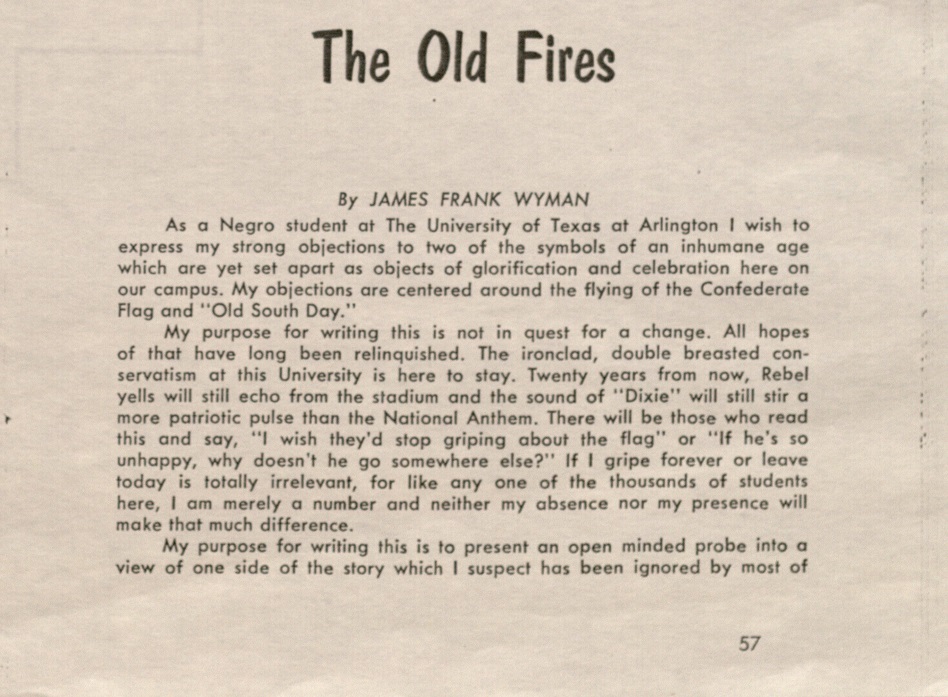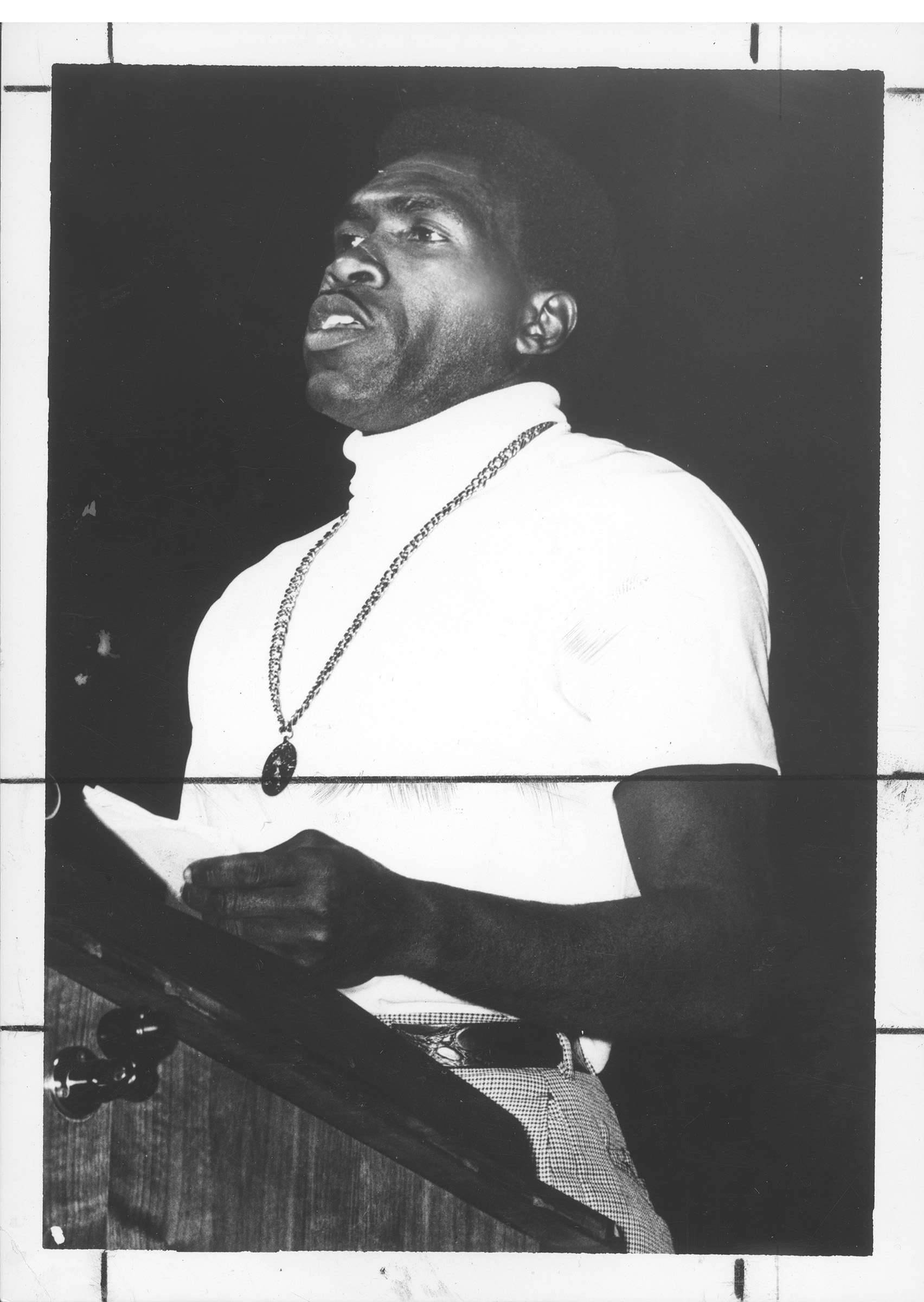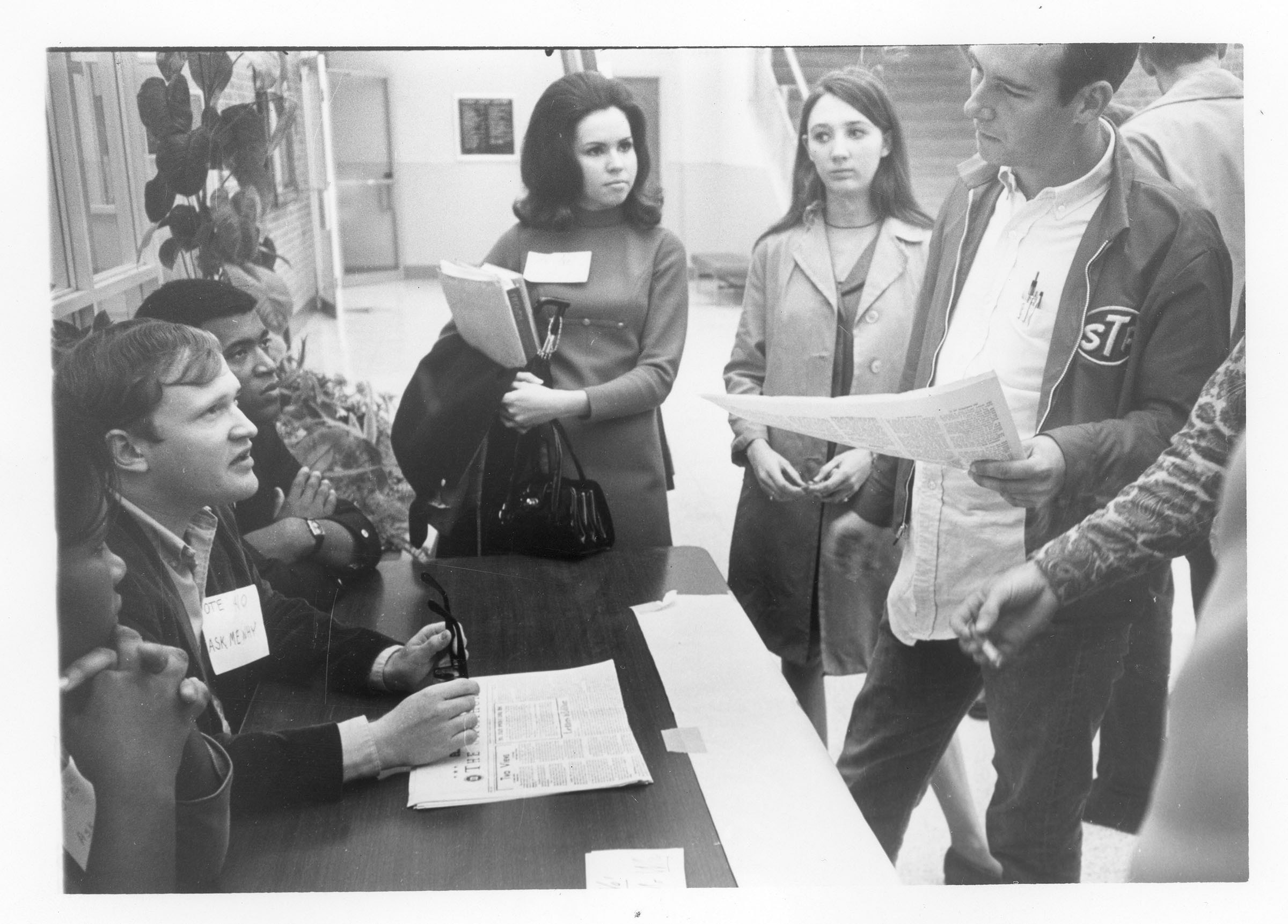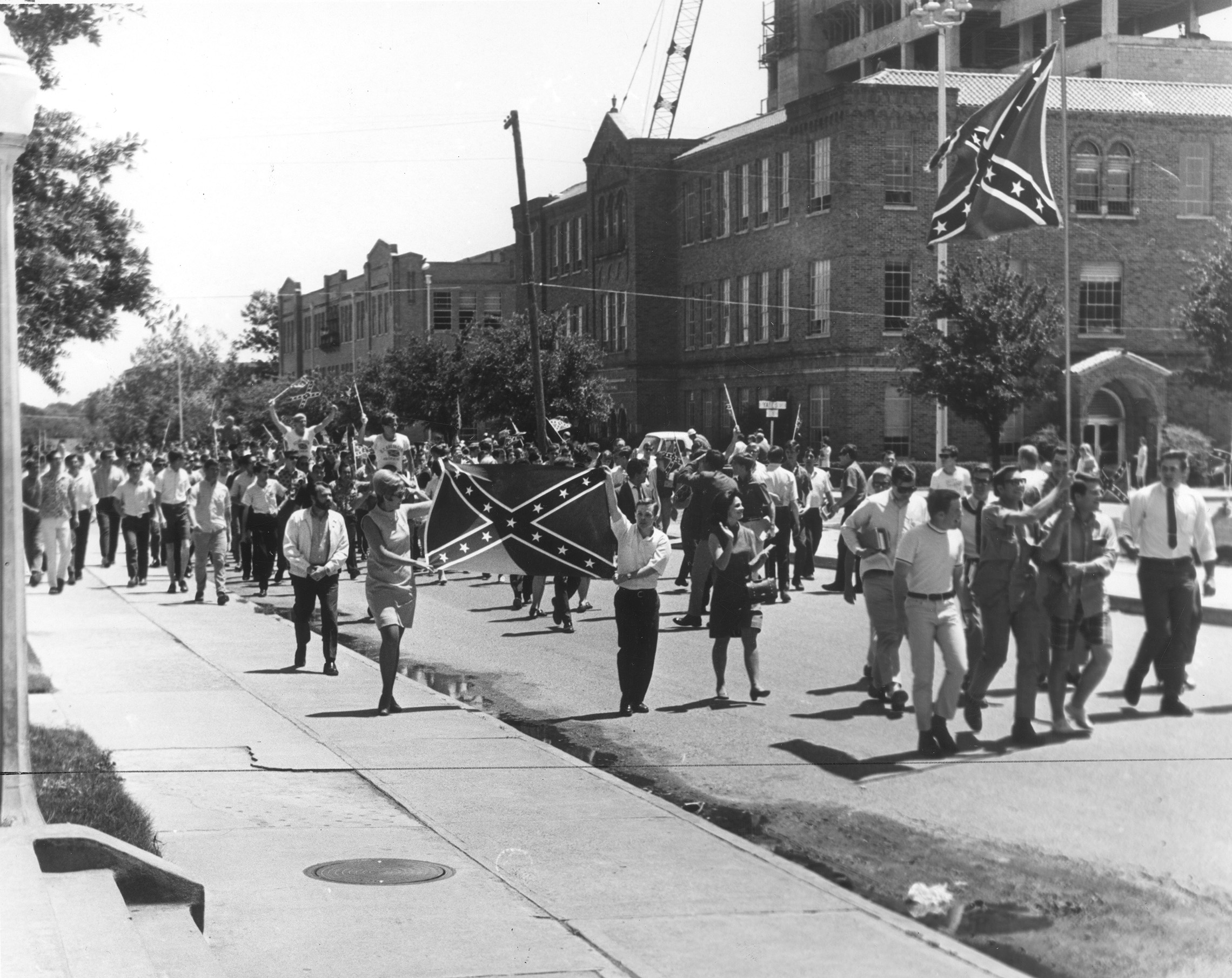
Challenging the Confederacy at UTA
The purpose of The Compass Rose is to raise awareness of Special Collections' resources and to foster the use of these resources. The blog series also reports significant new programs, initiatives, and acquisitions of Special Collections.
On May 6, 2021, President Teik C. Lim announced that the University of Texas System Board of Regents voted to approve changing the name of UTA’s Davis Hall to the University Administration Building. The building was named for Edward Everett Davis, who served as dean of the North Texas Agricultural College from 1925 to 1946. Davis was an advocate for segregation based on race and social status and the adoption of eugenics. Student activism was a core component of this necessary change, but this isn’t the first time that activists have worked to address harmful iconography on campus.
Student Activism in the 1960s
From 1951 to 1971, Johnny Reb, short for Rebel, was the mascot at Arlington State College (ASC). The campus adopted several symbols of the Confederacy, including the flying and waving of the Confederate battle flag on campus and at events. “Dixie,” which originated from minstrel shows in the 1850s and became the de facto national anthem of the Confederacy, was adopted as the school’s unofficial fight song as well. At this time, it was not uncommon for universities to use and retain these Confederate themes on college campuses, especially in the face of integration. The Confederate theme went beyond just a mascot. It encompassed many aspects of the campus identity including athletic uniforms and facilities, social activities, room names on campus, and décor used for school spirit.
Amid the Civil Rights and Black Power Movements, Black student activism in the 1960s was essential in enacting change on college campuses across the country. In her book The Black Revolution on Campus, Martha Biondi argues, “With remarkable organization and skill, this generation of Black students challenged fundamental tenants of university life. They insisted that public universities should reflect and serve the people of their communities” (Biondi, 2). Arlington State College was integrated in 1962 when Ernest Hooper, Jerry Hanes, and Leaston Chase were admitted after challenging the University with the help from the Dallas branch of the National Association of the Advancement of Colored People (NAACP). As the Black student population continued to grow on campus, the University began to see grassroots campaigns to eliminate the Rebel theme from campus.
Challenging Johnny Reb at UTA
The Rebel theme traces back to Arlington State College. In 1951, University President E. H. Hereford asked the student body to select a new mascot for the school. He presented students with two choices: Rebels or Cadets. The students voted to become the ASC Rebels. The following year “Dixie” became the unofficial school song and the Confederate battle flag became a symbol for school spirit. While the college was still segregated, students did not see a need to change the theme. In 1962, after the campus was integrated, an editorial in The Shorthorn asserted that it was time for a more representative school theme.
According to UTA professor Gerald Saxon, “The Rebel theme question lay dormant until 1965, the year the college joined the UT system” (Saxon, 113). That fall, 25 students held a peaceful protest in front of the student center to support abandoning the Rebel theme. Despite student protest, the theme remained. It wasn’t until 1967 that the issue was addressed again. James Frank Wyman published “The Old Fires” in the Arlington Review. He argued that “for people of color it symbolized slavery, racism, oppression, and segregation” (Saxon, 114).

First page of "The Old Fires" written by James Frank Wyman and published in the Arlington Review in 1967.
1968 saw more opposition and protest to the Confederate theme on campus. In the spring, The Shorthorn published another editorial calling for a change and 70 Black students petitioned student government to change the theme. Student Congress voted to remove the Confederate flag over the student center by July of that year. The rest of 1968 saw more vocalization about the issue in the student newspaper and a large opposition to changing the theme grew out of those events.
In the spring of 1969, the Collegians for Afro-American Progress (CAP) student group brought a list of demands to the University President Frank Harrison. Not only did these demands include changing the Rebel theme, but also hiring Black professors and creating an African American studies program. President Harrison rejected their requests. Later that year in October, 17 Black students disrupted a pep rally to demand the removal of the Kappa Alpha fraternity’s use of the Confederate flag at the event. The fraternity refused to remove the flag, which resulted in a physical altercation between the students. The following Saturday at the football game a group of students tried to enter the press box to address the crowd but were denied entry.
After months of protests, December 1969 saw another student vote on an alternative theme. 5,758 students voted between three different mascots: Mavericks, Texans, and Apollos. (Saxon 116). A runoff election was held in February 1970 and “Mavericks” beat "Texans” by 144 votes. In March 1970 another referendum was held, and students voted between the Mavericks and the Rebel themes. The Rebel theme won out and President Harrison continued to maintain that it was a student decision. Throughout the remainder of 1970 some changes on campus were made, such as President Harrison convincing the marching band to stop playing “Dixie” at football games. However, students in favor of the Rebel theme continued to demand Confederate themes throughout campus be brought back.
40 Years Later
The University of Texas System regents grew tired of the controversy and abolished the Rebel theme on January 29, 1971. Many were angry about the regents’ decision and, “the Roaring Reb attacked [President Harrison] for lying to the student body and suggested that he resign” (Saxon 118). Although some in UTA and local communities argued for the return of these Confederate symbols on campus, the Rebel theme was abolished for good. The official university mascot became the Mavericks following the UT System regents' decision. Forty years after the university saw a student movement to eliminate the Rebel theme from campus, UTA students yet again made a significant impact in making the campus more inclusive to the student body it serves.

Fahim Minkah (1939-2018), born Fred Bell, organized the first Black student organization at UTA and was one of the leaders of the movement to change the theme. He was a member of the Dallas chapters of SNCC and the Black Panther Party.
Bibliography
- Achigbu, Tritima and David Silva Ramirez. "Black on Campus" The history of integration, representation at UTA." The Shorthorn (Arlington, TX), July 1, 2020.
- Biondi, Martha. The Black Revolution on Campus. Berkely; Los Angeles; London: University of California Press, 2012.
- Black, Lisa. "Race-based tensions not new." Fort Worth Star-Telegram (Fort Worth, TX), April 30, 1995.
- "Confederate Flag at Arlington State College," from Fahim Minkah oral history interview with Katherine Bynum, August 26, 2017, Glenn Heights, TX, Civil Rights in Black and Brown Interview Database, https://crbb.tcu.edu/clips/7075/confederate-flag-at-arlington-state-college, accessed August 19, 2021
- Dunn, David. "UTA mascots change through time." The Shorthorn (Arlington, TX), November 12, 2013.
- Dorr, Kayla. "UTA celebrates journey to equality through Black History Month." The Shorthorn (Arlington, TX), January 30, 2013.
- Knowles, Samantha. "UTA students call to rename buildings with racist backgrounds." The Shorthorn (Arlington, TX), February 18, 2021.
- MA 2018.20 Fahim Minkah Papers. Dallas History & Archives Division. Dallas Public Library.
- Rebel Theme Controversy Collection, AR232, Special Collections, The University of Texas at Arlington Libraries.
- "Removing the Confederate Flag from UTA," from Fahim Minkah oral history interview with Katherine Bynum, August 26, 2017, Glenn Heights, TX, Civil Rights in Black and Brown Interview Database, https://crbb.tcu.edu/clips/7077/removing-the-confederate-flag-from-uta, accessed August 19, 2021
- Rimal, Shambhavi. "Student Senate passes resolution to rename Davis Hall, citing alleged racist behavior." The Shorthorn (Arlington, TX), April 14, 2020.
- Saxon, Gerald D. Transitions, A Centennial History of The University of Texas at Arlington. Arlington: UTA Press, 1995.
- "Student Organizing on Campus," from Fahim Minkah oral history interview with Katherine Bynum, August 26, 2017, Glenn Heights, TX, Civil Rights in Black and Brown Interview Database, https://crbb.tcu.edu/clips/6966/student-organizing-on-campus, accessed August 19, 2021
- University of Texas at Arlington Dean of Student Life Records, AR281, Special Collections, The University of Texas at Arlington Libraries.





Add new comment